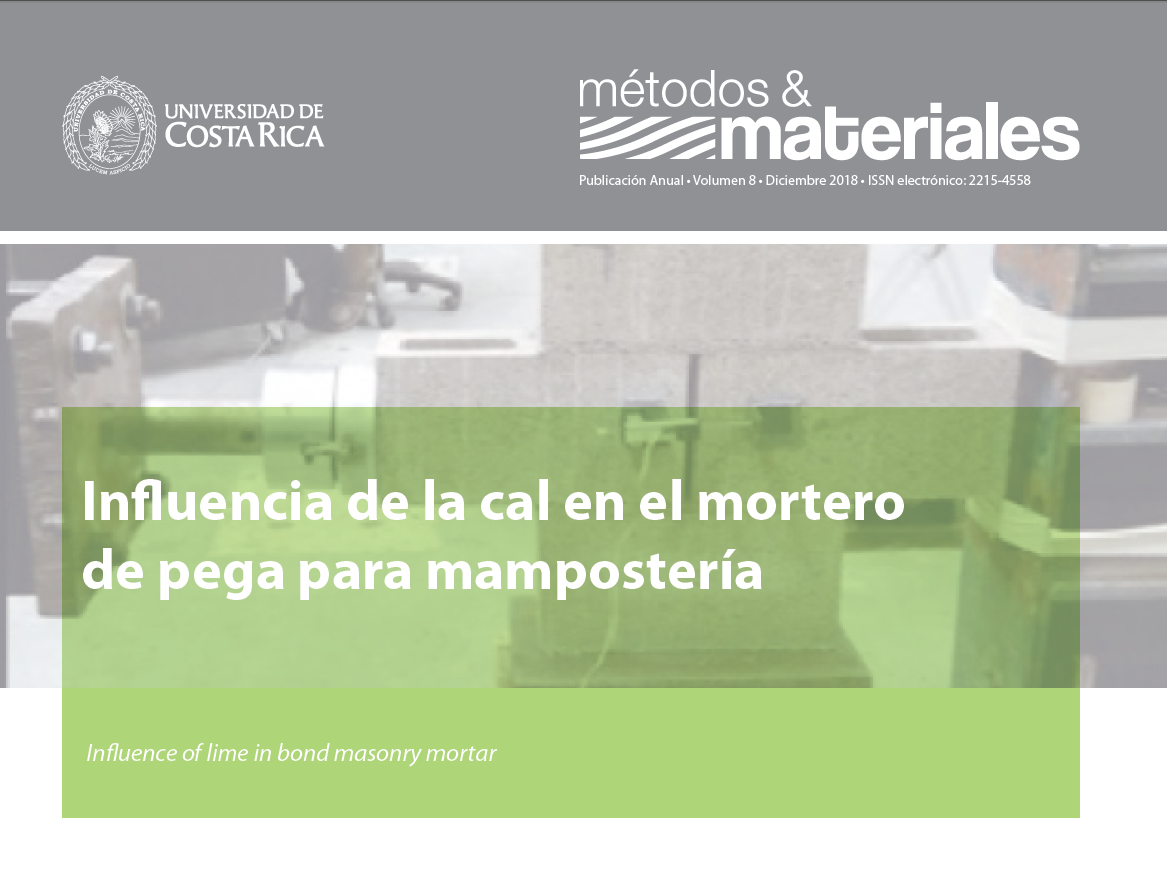Abstract
In this research it was studied the mortars for block pasting, fabricated in situ and the effects in their physical and mechanical characteristics by adding lime to the mix. For this, were made mortars type M and type S with and without lime, using the volumetric proportions that the Seismic Code of Costa Rica 2010 (CSCR 2010) says. It was used quarry sand and industrial sand like fine aggregate, separately. Testing compressive strength was conducted in mortar cubes at 7 and 28 days, also percentage of water retention, air content and workability were tested. Also, masonry prisms and “crosses” were made for compressive strength and bond test, respectively. All this, to determine if the use of lime produced in this country improves the properties of the bond masonry mortar, because this could reactivate in Costa Rica the use of lime in the Industrial construction.
Tests were made with 3 different limes, and the results change depends on the lime used. But in general, the lime improves some properties like water retention, workability and bond, and in some cases increases prisms resistance. Conversely, compressive strength in mortar cubes decreases and the air content wasn’t affected.
References
Acón, C. (2014). Influencia de la cal nacional en las propiedades el mortero para pega de bloques en mampostería. (Tesis de Grado). Universidad de Costa Rica.
American Society for Testing and Materials. (2006). ASTM C207. Standard Specificaion for Hydrated Lime for masonry Purposes. Anual Book of ASTM Standards. Philadelphia: ASTM International.
American Society for Testing and Materials. (2014). ASTM C270 - 14a. Standard Specification for Mortar for Unit Masonry Anual Book of ASTM Standards. Philadelphia: ASTM International.
American Society for Testing and Materials. (2015). ASTM C1506 - 17. Standard Test Method for Air Content of Hydraulic Cement Mortar Anual Book of ASTM Standards. Philadelphia: ASTM International.
American Society for Testing and Materials. (2016). ASTM C109/C109M - M16a. Standard Test Method for Compressive Strength of Hydraulic Cement Mortars (Using 2-in. or [50-mm] cube Specimens) Anual Book of ASTM Standards. Philadelphia: ASTM International.
American Society for Testing and Materials. (2016). ASTM C1314 - 16. Standard Test Method for Compressive Strength of Masonry Prisms Anual Book of ASTM Standards. Philadelphia: ASTM International.
American Society for Testing and Materials. (2015). ASTM C1437 - 15. Standard Test Method for Flow of Hydraulic Cement Mortar Anual Book of ASTM Standards. Philadelphia: ASTM International.
American Society for Testing and Materials. (2017). ASTM C1506 - 17. Standard Test Method for Water Retention of Hydraulic Cement-Based Mortars and Plasters Anual Book of ASTM Standards. Philadelphia: ASTM International.
American Society for Testing and Materials. (2017). ASTM C110 - 16e1. Standard Test Methods for Physical Testing of Quicklime, Hydrated Lime, and Limestone. Anual Book of ASTM Standards. Philadelphia: ASTM International.
Arias, E. (2012). Evaluación de las propiedades del mortero preempacado para pega de bloques de mampostería. (Tesis de Grado). Universidad de Costa Rica.
Campos, A. (2016). Influencia de la cal en las características físico mecánicas del mortero de pega para mampostería, fabricado con arena de tajo. (Tesis de Grado). Universidad de Costa Rica.
Chacón, C. (2001). Análisis y evaluación técnica en morteros para repellos y recomendaciones para su uso. (Tesis de Grado). Universidad de Costa Rica.
Colegio Federado de Ingenieros y Arquitectos (CFIA). (2010).
Código Sísmico de Costa Rica 2010 (Cuarta ed.). Cartago, Costa Rica: Editorial Tecnológica de Costa Rica.
Holcim. Ficha técnica Cemento UG-RTCR 383:2004; 2014.
León, Y. (2016). Influencia de la cal y la arean de río lavada, en las propiedades físico mecánicas del mortero de pega de bloques de mampostería. (Tesis de Grado). Universidad de Costa Rica.
Picado, A. (2001). Evaluación técnica de morteros para repello y recomendaciones para su aplicación. (Tesis de Grado). Universidad de Costa Rica.






